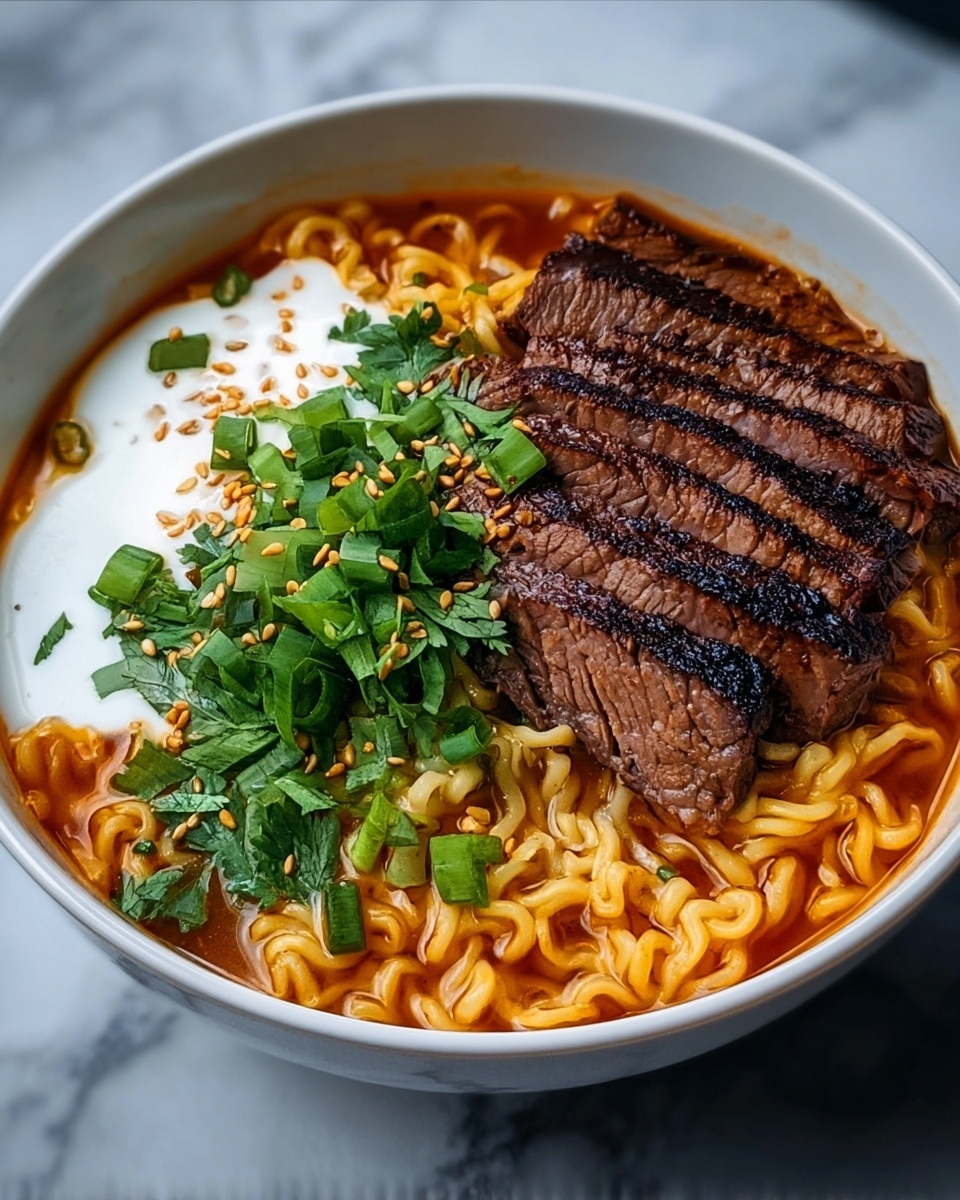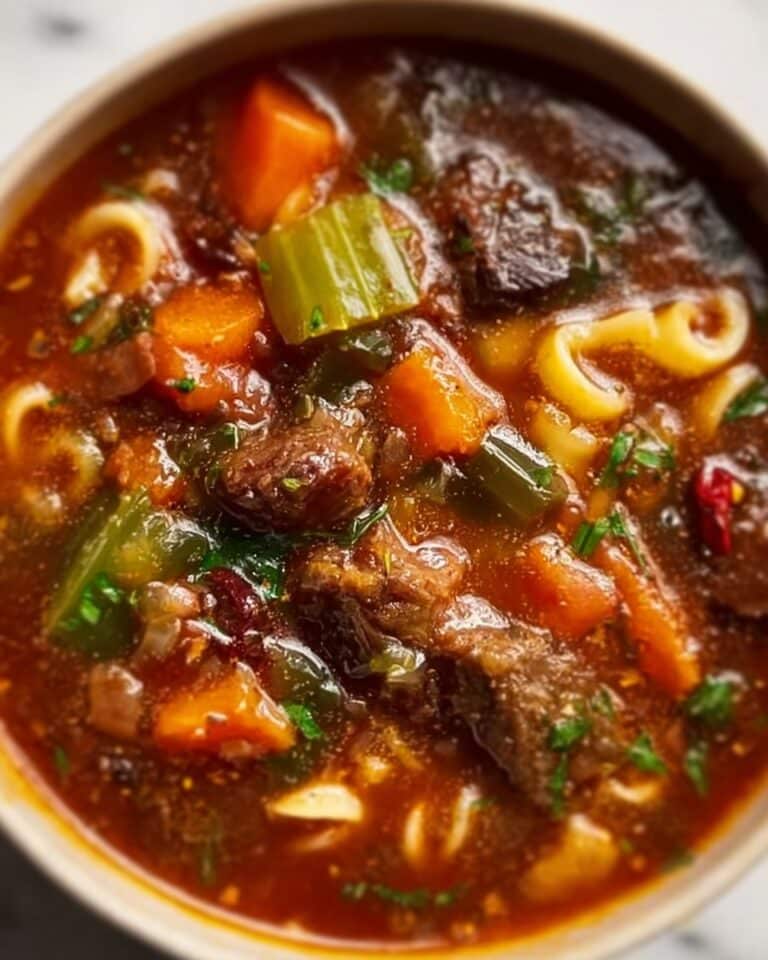“`html
If you’re craving something that perfectly balances bold spice, tender beef, and comforting noodles, this Spicy Korean Ramen Beef Recipe is exactly what you need on your table. It’s a burst of Korean flavors packed into a hearty bowl that’s as satisfying as it is vibrant. With tender marinated sirloin swimming in a savory, fiery broth alongside crisp vegetables and springy ramen, it’s an irresistible dish that truly warms the soul and excites your taste buds.

Ingredients You’ll Need
Getting your hands on these ingredients is a breeze but each plays a vital role in bringing this dish’s wonderful layers of flavor, texture, and color to life.
- 4 packets instant ramen noodles (Korean Shin Ramyun recommended for spice): The spicy base noodle that defines the dish’s character and heat level.
- 8 cups water: Essential for creating the broth that melds all ingredients beautifully.
- 1 pound beef sirloin, thinly sliced against the grain: Offers tender, juicy bites that soak up all the savory goodness.
- 2 tablespoons soy sauce: Delivers umami depth and balances out the spice.
- 1 tablespoon sesame oil: Adds a toasty, nutty aroma that’s utterly Korean in spirit.
- 1 tablespoon gochujang (Korean chili paste): Provides the distinct red pepper heat and a touch of sweetness.
- 1 teaspoon minced garlic: Boosts pungency and layers of flavor.
- 1/2 teaspoon ground ginger: Brightens the broth with a subtle zing.
- 1/4 teaspoon black pepper: Adds a mild peppery note that awakens the palate.
- 1 tablespoon vegetable oil: For sautéing and bringing everything together.
- 1 medium onion, thinly sliced: Sweetness and texture contrast.
- 2 cloves garlic, minced: Intensifies the savory kick in the veggie sauté.
- 1 red bell pepper, thinly sliced: Adds vibrant color and gentle crunch.
- 1 green bell pepper, thinly sliced: For fresh, crisp flavor and balance.
- 4 ounces mushrooms, sliced (shiitake, cremini, or button): Injectable umami and earthiness.
- 2 green onions, thinly sliced, for garnish: Bright, mild onion aroma for freshness.
- 1 cup bean sprouts: Brings a crisp, clean bite in the broth.
- 1/2 cup kimchi, chopped (optional, for extra spice and flavor): Adds an irresistible fermented tang and heat.
- 2 tablespoons soy sauce: For adjusting seasoning at the end for balance.
- 1 tablespoon gochugaru (Korean chili flakes, adjust to taste): Elevates the spicy kick with a smoky touch.
- 1 teaspoon sugar: Just enough sweetness to round off the flavors.
- 1 teaspoon fish sauce (optional, for umami): Depth and savoriness that’s subtle but impactful.
- 2 soft-boiled eggs, halved: Creamy, rich texture that soothes the spicy broth.
- Sesame seeds, for garnish: Nutty crunch that finishes the dish beautifully.
- Nori seaweed sheets, cut into strips: Adds a briny, oceanic twist and visual appeal.
How to Make Spicy Korean Ramen Beef Recipe
Step 1: Prepare the Beef
Begin by marinating the thinly sliced beef sirloin with soy sauce, sesame oil, gochujang, minced garlic, ground ginger, and black pepper. This step ensures every bite of beef absorbs the bold Korean spices and rich umami, which makes the meat incredibly flavorful and tender. Letting it rest for at least 15 minutes allows the flavors to penetrate deeply.
Step 2: Sauté the Vegetables and Beef
Heat vegetable oil in a large pot over medium-high heat and sauté the onions until they turn translucent. Add the minced garlic until fragrant, then toss in the marinated beef and cook until nicely browned on all sides. Next, introduce the red and green bell peppers along with the mushrooms, cooking until just tender-crisp. If you love some extra spice and complexity, stir in chopped kimchi now for a tangy punch that complements the beef beautifully.
Step 3: Cook the Ramen and Enhance the Broth
Pour 8 cups of water into the pot and bring it to a boil. Add the ramen noodles, cooking according to the package directions, usually around 3 to 5 minutes. While the noodles soften, stir in soy sauce, gochugaru, sugar, and fish sauce if you’re using it. These additions deepen the broth’s flavor and balance its spicy heat with savory sweetness. Finally, toss in the bean sprouts during the last minute to keep them crisp and fresh.
Step 4: Assemble and Serve
Divide the ramen, beef, and vegetables evenly into bowls, ladling the hot broth over. Garnish with sliced green onions, sesame seeds, and if you want to go all out, add a soft-boiled egg half and strips of nori seaweed. This final presentation brings a stunning mix of textures and flavors. Serve immediately to enjoy the dish at its best—warm, hearty, and packed with vibrant Korean taste.
How to Serve Spicy Korean Ramen Beef Recipe

Garnishes
Green onions and sesame seeds are classic for a reason—they provide fresh aroma and nutty crunch that brighten the spicy broth. Soft-boiled eggs are a must for their creamy richness, and nori strips bring a delicate oceanic flavor. These simple touches elevate the dish from everyday to extraordinary.
Side Dishes
This dish is wonderfully hearty on its own, but pairing it with light sides like crisp cucumber kimchi, pickled radish, or steamed edamame enhances the meal. These sides add refreshing contrast and layers of traditional Korean flavors that complement the spicy ramen beef.
Creative Ways to Present
If you want to impress friends or family, serve the ramen in stone bowls to keep it piping hot longer. Garnish with a drizzle of toasted sesame oil or a sprinkle of crushed toasted peanuts for more texture. For a colorful twist, add julienned carrots or sliced chili peppers on top—making each bowl as visually exciting as it tastes.
Make Ahead and Storage
Storing Leftovers
Leftover Spicy Korean Ramen Beef keeps well in an airtight container in the refrigerator for up to three days. Store the noodles separately if possible to prevent them from becoming overly soggy, then combine when reheating for the best texture.
Freezing
The broth with beef and vegetables can be frozen, but it’s best to freeze without the noodles and garnishes. Use freezer-safe containers and consume within two months for optimal flavor retention. Thaw overnight in the refrigerator before reheating gently on the stove.
Reheating
Reheat the broth, beef, and vegetables in a pot over medium heat, adding fresh noodles during the last few minutes of cooking. Stir gently to combine and warm through without overcooking the noodles. Garnish freshly after heating to maintain their brightness and texture.
FAQs
Can I use other noodles instead of Korean ramen?
Absolutely! While Korean Shin Ramyun adds that signature spicy depth, you can substitute with other instant ramen or even fresh noodles. Just adjust cooking time to avoid overcooking.
What if I don’t like spicy food? Can I still make this?
You can reduce the gochujang and gochugaru amounts or omit them altogether for a milder version. Adding a little extra soy sauce or a touch of sugar can balance the flavors well.
Can I use different types of beef?
Yes, other tender cuts like ribeye or flank steak work nicely. Just slice thinly against the grain to keep the meat tender and quick-cooking.
Is kimchi necessary in this recipe?
Kimchi is optional but highly recommended for its fermented tang and added spice complexity. If you don’t have it, you can skip or substitute with pickled vegetables for some acidity.
How do I make the perfect soft-boiled eggs?
Boil eggs for exactly 6 to 7 minutes, then immediately transfer to an ice bath to stop cooking and make peeling easier. The yolks should be slightly runny and creamy, perfect for ramen bowls.
Final Thoughts
There’s something truly special about a bowl of Spicy Korean Ramen Beef Recipe that just feels like a warm hug on a chilly day. Whether you’re a seasoned lover of Korean cuisine or exploring it for the first time, this recipe brings exciting flavors in a comforting, approachable way. I hope you give it a try soon—it’s destined to become one of your favorite go-to meals when you want something spicy, satisfying, and delightfully homemade.
“`
Print
Spicy Korean Ramen Beef Recipe
- Total Time: 45 minutes
- Yield: 4 servings 1x
Description
Spicy Korean Ramen Beef is a flavorful and easy-to-make dish combining tender marinated beef, sautéed vegetables, and spicy Korean ramen noodles in a rich, savory broth. This recipe features the iconic Korean Shin Ramyun noodles and a blend of traditional Korean seasonings like gochujang and gochugaru, perfect for a satisfying and warming meal in just 45 minutes.
Ingredients
Beef Marinade
- 1 pound beef sirloin, thinly sliced against the grain
- 2 tablespoons soy sauce
- 1 tablespoon sesame oil
- 1 tablespoon gochujang (Korean chili paste)
- 1 teaspoon minced garlic
- 1/2 teaspoon ground ginger
- 1/4 teaspoon black pepper
Main Ingredients
- 4 packets instant ramen noodles (Korean Shin Ramyun recommended for spice)
- 8 cups water
- 1 tablespoon vegetable oil
- 1 medium onion, thinly sliced
- 2 cloves garlic, minced
- 1 red bell pepper, thinly sliced
- 1 green bell pepper, thinly sliced
- 4 ounces mushrooms, sliced (shiitake, cremini, or button)
- 1 cup bean sprouts
- 1/2 cup kimchi, chopped (optional, for extra spice and flavor)
- 2 soft-boiled eggs, halved
- Sesame seeds, for garnish
- Nori seaweed sheets, cut into strips
Seasonings for Broth
- 2 tablespoons soy sauce
- 1 tablespoon gochugaru (Korean chili flakes, adjust to taste)
- 1 teaspoon sugar
- 1 teaspoon fish sauce (optional, for umami)
Instructions
- Preparing the Beef: In a medium bowl, combine the thinly sliced beef sirloin with soy sauce, sesame oil, gochujang, minced garlic, ground ginger, and black pepper. Mix well ensuring the beef is evenly coated. Let it marinate for at least 15 minutes, up to 30 minutes in the refrigerator for deeper flavor.
- Sautéing the Vegetables and Beef: Heat vegetable oil in a large pot or Dutch oven over medium-high heat. Add the sliced onion and cook until softened and translucent, about 3-5 minutes. Add minced garlic and cook for another minute until fragrant. Add the marinated beef and cook until browned on all sides, approximately 5-7 minutes. Add sliced red and green bell peppers and mushrooms; cook until vegetables are tender-crisp, about 3-5 minutes. If using kimchi, stir it in now and cook for an additional minute to combine flavors.
- Cooking the Ramen and Enhancing the Broth: Pour 8 cups of water into the pot with sautéed vegetables and beef, bring to a boil. Once boiling, add ramen noodles and cook according to package directions, usually 3-5 minutes. While noodles cook, stir in soy sauce, gochugaru, sugar, and fish sauce if using. Mix well to dissolve sugar and blend flavors. Taste broth and adjust seasoning if needed. Add bean sprouts during the last minute of cooking.
- Assembling and Serving: Divide ramen noodles, beef, vegetables, and broth evenly into four bowls. Garnish each bowl with sliced green onions, sesame seeds, halved soft-boiled eggs, and strips of nori seaweed if desired. Serve immediately for best taste and texture.
Notes
- Marinate the beef for longer if time allows, up to 30 minutes, for more intense flavor.
- Adjust gochugaru and gochujang quantities to control the spice level according to your preference.
- Soft-boiled eggs can be prepared ahead by boiling eggs for 6-7 minutes and cooling in ice water before peeling.
- Kimchi is optional but highly recommended to add extra depth and spice.
- Use Korean Shin Ramyun noodles for authentic spicy flavor, but other instant ramen can work if unavailable.
- For a vegetarian version, omit beef and fish sauce, substitute with tofu and vegetable broth.
- Prep Time: 15 minutes
- Cook Time: 30 minutes
- Category: Main Course
- Method: Stovetop
- Cuisine: Korean







